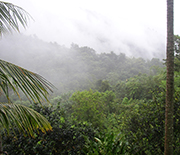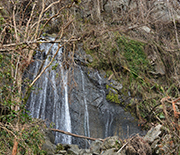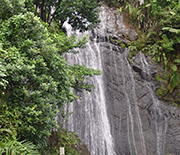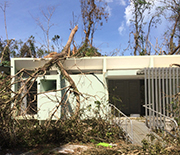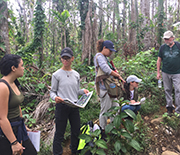News Release 18-112
After the hurricane: Maria’s far-reaching effects on Puerto Rico’s watersheds and forests
Tree species and stream and forest nutrients altered, with ecosystem-wide consequences
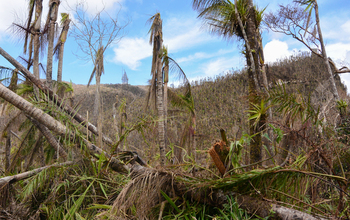
Puerto Rico's forests and streams were dramatically changed by Hurricane Maria's hit on the island.
December 10, 2018
This material is available primarily for archival purposes. Telephone numbers or other contact information may be out of date; please see current contact information at media contacts.
Find related stories on NSF's Critical Zone Observatories Sites. Find related stories on NSF's Long-Term Ecological Research Sites.
With fierce winds and flooding rains, hurricanes can be disasters for people -- and for ecosystems. These devastating storms have major effects on tropical forests, demolishing tree canopies and leaving behind debris that piles up in watershed streams and on forest floors.
Scientists at the National Science Foundation (NSF) co-located Luquillo Critical Zone Observatory (CZO) and Long-Term Ecological Research (LTER) sites in Puerto Rico spent the past year evaluating the impacts of Hurricane Maria, a powerful category 5 storm that struck Puerto Rico head-on in September 2017.
The researchers reported their results today at a press conference -- Puerto Rico one year later: Hurricane Maria's lasting footprint -- at the American Geophysical Union fall meeting in Washington, D.C.
Increased nitrate flowing downstream
After Maria, sensors measuring nitrate in streams at the NSF Luquillo CZO site showed a dramatic increase in how much of the nutrient was transported from mountain headwaters to the sea, according to biogeochemist William McDowell of the University of New Hampshire.
Nitrate is essential for plant growth. In large quantities, however, it can be harmful to coastal ecosystems. After major hurricanes like Maria and the tremendous changes they produce in vegetation, nitrate escapes from damaged forests and is flushed downstream, says McDowell.
"The implication of the loss of nitrogen from an ecosystem is uncertain," says McDowell, "but is likely to play a role in which trees grow back first." The downstream delivery of nitrate to coastal waters may also fuel algae blooms and, eventually, coastal dead zones.
Dead and broken trees
Based on data collected at the NSF Luquillo LTER site, Hurricane Maria killed twice as many trees as previous storms and tripled the number of broken trees, found ecologist Maria Uriarte of Columbia University. Palm trees were the exception; their sinewy stems bent in the wind and their fronds began to grow back almost immediately after the storm.
Future storms of Maria's strength could switch the dominant trees in Puerto Rico's forests from tall hardwoods to palms, Uriarte says, with consequences for whether forests take up more carbon or release carbon into the atmosphere.
Research offers new insights
McDowell and Uriarte will present their scientific findings on Friday, Dec. 14, in a conference session on "Tropical Forests in a Changing Environment."
Their studies at Luquillo address long-term climate patterns, disturbances such as hurricanes and landslides, and the legacies of land use history in forest and stream ecosystems. By understanding how nutrient cycles -- and plant and animal populations -- respond to natural and human disturbances, scientists can supply the information needed to model, manage and conserve tropical forest ecosystems.
Research at the NSF Luquillo CZO site focuses on physical and chemical processes in a mountain watershed. Scientists conducting research at the Luquillo CZO study such subjects as mineral weathering, nutrient transport, and changing water, dust and sediment inputs to the ecosystem.
NSF Luquillo LTER research includes long-term observations of species and ecosystems; the connections between forest and stream ecology; and the ways mountains and precipitation interact. Experiments simulate the effects of hurricane intensity on forest and stream ecology.
-NSF-
-
The NSF Luquillo CZO-LTER site before the passage of Hurricane Maria.
Credit and Larger Version -
A Luquillo waterfall after the storm: Downed trees have fallen across the stream.
Credit and Larger Version -
A Luquillo waterfall before Hurricane Maria - trees thrive along the streambank.
Credit and Larger Version -
The NSF Luquillo field station was in the direct path of the hurricane.
Credit and Larger Version -
NSF Luquillo researchers work to plant new trees in hurricane-damaged forests.
Credit and Larger Version
Media Contacts
Cheryl Dybas, NSF, (703) 292-7734, email: cdybas@nsf.gov
Related Websites
Can an ancient ocean shoreline set the stage for a tropical forest of today?: https://nsf.gov/discoveries/disc_summ.jsp?cntn_id=242383
El Yunque, Majestic Rocky Icon of Puerto Rico: Impervious to the Ravages of Time?: https://www.nsf.gov/discoveries/disc_summ.jsp?cntn_id=126969
The U.S. National Science Foundation propels the nation forward by advancing fundamental research in all fields of science and engineering. NSF supports research and people by providing facilities, instruments and funding to support their ingenuity and sustain the U.S. as a global leader in research and innovation. With a fiscal year 2023 budget of $9.5 billion, NSF funds reach all 50 states through grants to nearly 2,000 colleges, universities and institutions. Each year, NSF receives more than 40,000 competitive proposals and makes about 11,000 new awards. Those awards include support for cooperative research with industry, Arctic and Antarctic research and operations, and U.S. participation in international scientific efforts.
Connect with us online
NSF website: nsf.gov
NSF News: nsf.gov/news
For News Media: nsf.gov/news/newsroom
Statistics: nsf.gov/statistics/
Awards database: nsf.gov/awardsearch/
Follow us on social
Twitter: twitter.com/NSF
Facebook: facebook.com/US.NSF
Instagram: instagram.com/nsfgov

